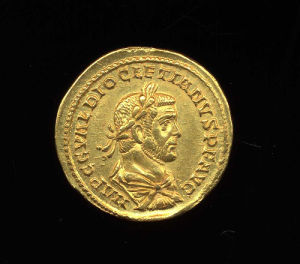Server check!
You are on the training database
Diocletian
Reece Period attributed: Period 14

Member of the The Tetrarchy dynasty.
Coins for this issuer were issued from 284 until 305.
Gaius Aurelius Valerius Diocletianus was born ca. 245 in Dalmatia. He came from humble origins and rose through the military to serve as commander at Moesia. Diocletian may have played some part in the deaths of Carus and Numerian; his troops proclaimed him emperor and he marched against Carinus in Rome. Carinus met him in battle and was ultimately killed, and Diocletian gained the support of his troops.
In 285, Diocletian appointed his colleague Maximian as Caesar and gave him control of the Western provinces; the emperor had no sons on whom to rely. In 286 Maximian was raised to Augustus, and propaganda tended to identify Diocletian with Jove and Maximian with Hercules.
Diocletian spent five years campaigning against the Danube tribes and unsuccessfully dealing with the upstart Carausius. Although the dual emperor system worked well, he began to worry about the succession. As a solution, Diocletian and Maximian each appointed a junior Caesar to succeed when either of the Augusti died (Constantius and Galerius.)
Diocletians reorganization of the imperial system proved his greatest contribution to the Roman empire. The Senates influence was on the decline, and the empire was divided into more orderly provinces, with stricter rules about their governance. He is also remembered for reinstating worship of the traditional Roman pantheon and persecuting Christians.
Diocletian and Maximian gave up power in 205, and Diocletian retired to Split (in modern Croatia) where he died in 311.
Other resources about Diocletian
- Dbpedia: http://dbpedia.org/resource/Diocletian
- Wikipedia: http://en.wikipedia.org/wiki/Diocletian
- VIAF: http://viaf.org/viaf/70259756
View all coins recorded by the scheme attributed to Diocletian.
Information from Wikipedia
_-_Foto_G._Dall'Orto_28-5-2006_(cropped).jpg?width=300)
- Preferred label: Diocletian
- Full names:
- Consul of the Roman Empire
- List of Roman emperors
- Imperial Roman consuls
- Illyrian emperors
- 3rd-century Roman emperors
- Crisis of the Third Century
- Roman pharaohs
- Deified Roman emperors
- People of the Roman–Sasanian Wars
- 240s births
- 311 deaths
- Burials in Croatia
- Diocletian
- Imperial Roman slaves and freedmen
- People from Roman Dalmatia
- History of Split, Croatia
- Monarchs who abdicated
- Roman emperors to suffer posthumous denigration or damnatio memoriae
- Valerii
- 4th-century Roman emperors
- Aurelii
- Tetrarchy
Denominations issued
- Argenteus - view all records of this denomination issued by Diocletian
- As - view all records of this denomination issued by Diocletian
- Aureus (Republic/Empire) - view all records of this denomination issued by Diocletian
- Denarius (Empire) - view all records of this denomination issued by Diocletian
- Dupondius - view all records of this denomination issued by Diocletian
- Sestertius - view all records of this denomination issued by Diocletian
- Semis - view all records of this denomination issued by Diocletian
- Dupondius or as - view all records of this denomination issued by Diocletian
- Nummus (AE 1 - AE 4) - view all records of this denomination issued by Diocletian
- Quadrans - view all records of this denomination issued by Diocletian
- Quinarius - view all records of this denomination issued by Diocletian
- Radiate (antoninianus) - view all records of this denomination issued by Diocletian
- Medallion - view all records of this denomination issued by Diocletian
Issuing mints
This video has been embedded from Adrian Murdoch's series of podcasts on the Emperors of Rome. Many thanks to him for allowing us to use these podcasts.


